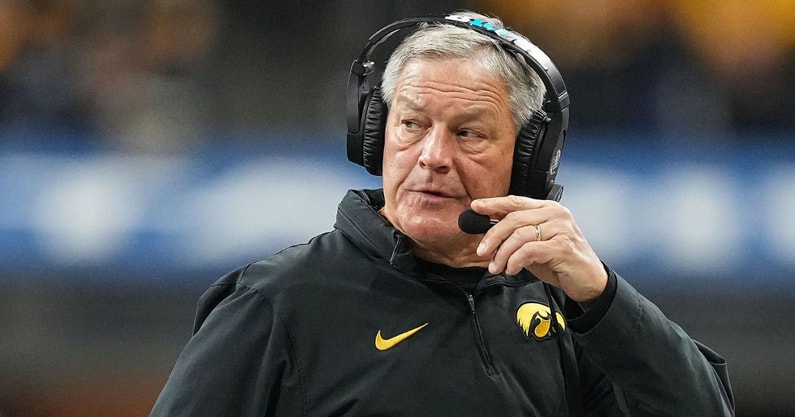Kirk Ferentz calls out uncertainty around roster limits after House settlement final approval delay

Ahead of the 2025 season, schools began to prepare for roster limits that would be in place under the House v. NCAA settlement. For football, that figure is 105 – although the final approval process hit a snag last week.
After telling attorneys for both sides to address her concerns around roster limits, Judge Claudia Wilken said she would deny final approval if the NCAA does not either phase in or grandfather those numbers. She gave attorneys two weeks to do so, meaning they have until May 7. If fully approved, the settlement would be effective July 1.
To Iowa coach Kirk Ferentz, Wilken’s order adds a new level of uncertainty. Considering the season begins in just over four months, he lamented the current state of college football.
“Not to make light of it, but this really says it all,” Ferentz said on SiriusXM College. “It’s … April 29, and we still have no idea what the rules are here for August. Think about that for a second. College football’s a fairly significant – it’s a big operation. A lot of revenue. It’s all we talk about anymore, is revenue.
“A lot at stake here, and we still don’t know what the rules are. That shows you just how screwed up things are right now, quite frankly. I guess that’s one good thing about getting older. I’ve learned not to sweat everything or rise and fall with every little thing that goes on. We’ll figure it out as it goes.”
Top 10
- 1Breaking
Rivals x On3
On3 acquires Rivals
- 2Hot
Paul Finebaum
Josh Heupel job security
- 3Trending
Bill Belichick
CBS News fires back at UNC coach
- 4
Jordan Travis
Retires from football
- 5
Ian Schieffelin
Joining Clemson football team
Get the On3 Top 10 to your inbox every morning
By clicking "Subscribe to Newsletter", I agree to On3's Privacy Notice, Terms, and use of my personal information described therein.
Kirk Ferentz: Roster limits ‘puts us at a little bit of a disadvantage’
Roster limits took center stage at the House v. NCAA settlement final approval hearing April 7. Wilken cited concerns about that part of the agreement – not because of the numbers, but because she wanted to look out for athletes currently on rosters who would be in danger of losing their spots.
Coaches, however, have made their concerns known about the impending roster limits and the future of walk-ons. Kirk Ferentz also compared it to his time in the NFL, where rosters cannot have more than 53 players after training camp. The difference, though, is teams can quickly replace players via free agency or the practice squad. That’s not the case in college.
“The 105 thing is, I think, maybe the most significant change as anything that has been discussed,” Ferentz said. “I think it’s just really, not rooted [in] much good reason, from my vantage point. I’m a coach. It’s got to be financially driven. I don’t know how else we would’ve come up with that number. It’s really not practical in a college environment, in my opinion. I’ve coached in the NFL, I’ve coached, obviously, in college for quite sometime. In the NFL, it’s a little different animal. You can be sitting there in October and you have three players get injured. You’ve got to put them on injured reserve. You go out and sign three guys or elevate three guys off your practice squad. It’s a fluid process where you’re never dropping down below. That’s one significant factor.
“And then, college situations. If you look at a place like ours – put it in NFL terms. In the NFL, you’ve got 53 guys on your roster. We may have 35 here that are NFL-ready, and then we’ve got 30-some guys on our practice squad instead of wherever the NFL’s at now. … We’re trying to develop our guys as they go through their careers. Our guys don’t walk in here ready made. To me, this limitation puts us at a little bit of a disadvantage.”